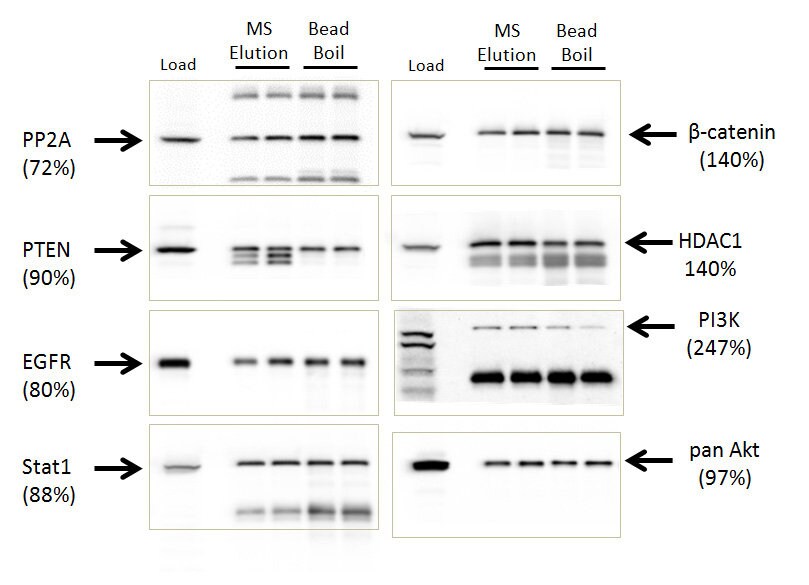Search
亲和素-生物素的相互作用
简介:生物素-亲和素的相互作用
亲和素是来源于鸟动物和两栖动物的一种蛋白质,显示出对生物素相当大的亲和力,这是一种在多种真核生物过程中起作用的共因子。亲和素 和其他生物素结合蛋白(包括链霉亲和素和 Neutr亲和素 蛋白)能够结合多达四个生物素分子,如下图所示,这种相互作用非常适合纯化和检测策略。

生物素-亲和素相互作用示意图。亲和素、链霉亲和素或中性链霉亲和素蛋白最多可与四个生物素分子结合,这些生物素分子通常与酶、抗体或目标蛋白结合形成亲和素-生物素复合物。
†表示 亲和素 通常还与抗体、目标蛋白或固定载体结合
使用生物素-亲和素系统的优势
生物素-亲和素复合物是蛋白质与配体之间已知最强的非共价相互作用(Kd = 10-15M)。生物素和 亲和素 之间的结合非常迅速,一旦形成,不受极端pH值、温度、有机溶剂和其他变性剂的影响。生物素和 亲和素 的这些特性—链霉亲和素和 Neutr亲和素 蛋白也具有这些特性—对于纯化或检测与相互作用中的任一成分结合的蛋白质非常有用。
生物素-亲和素相互作用的应用包括:
与二抗一样,生物素-亲和素检测系统能够轻松捕获、回收、固定或检测几乎无限数量的一抗试剂(即抗体、核酸探针和配体),而只需极少量通过修饰 亲和素 或链霉亲和素产生的二抗试剂。此外,如果没有特定的生物素化分子,市面上有许多试剂可用于在实验室进行生物素化。同样,亲和素和链霉亲和素也可以根据需要进行修改。
.jpg)
免疫组织化学分析。使用高灵敏度 Neutr亲和素-HRP Pierce 高灵敏度 Neutr亲和素-HRP 结合物检测人类结肠癌中的 GAPDH 和细胞角蛋白 18。
阿维丁-生物素技术手册
我们的《阿维丁-生物素技术手册》共 48 页,汇集了生物素化、纯化或检测蛋白质所需的一切。特色产品包括细胞表面蛋白生物素化和纯化试剂盒、抗体标记和新型光反应生物素化试剂。本手册包括数十种参考文献以及操作规程、故障排除技巧、选择指南和可用工具的完整列表。
使用生物素-亲和素系统的缺点
尽管生物素-亲和素系统易于设置和使用,但它确实存在一些局限性。由于任何生物素化的分子都会与任何生物素结合蛋白结合,因此这些试剂必须与其他检测探针系统(即一抗-二抗)结合使用,以进行多个实验。
此外,由于生物素是一种生物分子,当使用某些富含生物素的组织或提取物(如脑、肝、奶、蛋、玉米)进行检测时,内源性生物素可能会导致背景和特异性问题。这也适用于含有内源性生物素结合蛋白的样本,如鸡蛋(抗生物素蛋白的来源)或细菌,如链霉菌 (链霉亲和素的来源)。

NHS- 去硫生物素的化学结构。请注意右侧的修饰环结构(天然生物素具有双环结构,可嵌入到 亲和素、链霉亲和素或 Neutr 亲和素的结合位点)。
在纯化应用中,生物素和亲和素之间的结合强度是限制其应用的一个因素。这是因为需要苛刻的条件才能破坏生物素-亲和素键(即解离和洗脱),而这些条件可能会使目标蛋白变性。为了克服这一限制,市场上有亲和素树脂的改良版和生物素标记试剂的改良版,它们使相互作用易于逆转。这些试剂包括单体抗生物素蛋白、可裂解二硫键生物素试剂、亚氨基生物素和去硫生物素衍生物(见下文“蛋白质分离和富集”)。
生物素和生物素结合蛋白
生物素
生物素是一种维生素(维生素 H、维生素 B7、辅酶 R),在所有活细胞中含量都很少,对细胞生长和柠檬酸循环等许多生物过程至关重要。生物素在玉米粒、蛋黄、大脑、肝脏和血液等某些植物和动物组织中含量丰富。生物素分子的戊酸侧链可以衍生,以便结合各种反应基团,从而将生物素标签添加到其他分子上。由于生物素相对较小(244.3 Daltons),它可以与许多蛋白质和其他分子结合,而不会显着改变它们的生物活性。生物素结合蛋白与生物素之间高度特异性的相互作用使其成为检测和靶向生物分析物的检测系统中的有用工具。

生物素的化学结构。生物素,也称为维生素 B7(以前称为维生素 H 和辅酶 R),是一种水溶性物质。该分子由一个脲环和一个四氢噻吩环连接而成。生物素是羧化酶的辅酶,脂肪酸、异亮氨酸和 缬氨酸等分子的合成需要生物素。生物素还参与糖异生。
一旦生物素附着在分子上,就可以利用固定化的生物素结合蛋白,通过生物素标签来促进该分子的亲和纯化。或者,生物素化的分子可以通过与生物素结合蛋白相互作用而固定,然后用于亲和纯化与其特异性相互作用的其它分子(即共免疫沉淀或沉降分析)。 在免疫组织化学和免疫印迹中,生物素通常与一抗或二抗结合,然后通过结合酶、荧光团或其他报告分子的生物素结合蛋白检测生物素标签。许多蛋白质(如抗体)可以被多个生物素标签标记,每个标签都可以与生物素结合蛋白结合。优化后的生物素与探针的比例可以大大提高检测系统的信号输出,从而实现高度灵敏的检测。
生物素标记的抗体和其他分子可以从商业供应商处轻松获得,这使得检测方法的开发成为许多应用的常规手段。对于没有生物素化探针的检测方法,有许多生物素化试剂可以帮助研究人员对蛋白质、核酸和表面材料进行化学标记,以定制检测试剂。
继续阅读:链霉(亲和素)-生物素复合物法用于 免疫组织化学 检测
立即查看:抗生物素抗体
立即查看:生物素标记的二抗
立即查看:链霉亲和素/生物素结合蛋白结合物
亲和素
亲和素是一种生物素结合蛋白,据信在鸟类、爬行动物和两栖动物的卵中具有抗生素的作用。鸡的亲和素质量为 67,000-68,000 daltons,由四个 128 个氨基酸亚基组成,每个亚基结合一个生物素分子。亲和素高度糖基化,总质量中约有 10% 是碳水化合物,这使其基本等电点(pI)为 10-10.5,且在水中和含水盐溶液中具有高溶解度。由于亲和素很容易从鸡蛋清中纯化出来,因此生产成本很低(比链霉亲和素低得多)。
亲和素对多达四个生物素分子具有极高的亲和力,并且在广泛的 pH 值和温度范围内保持稳定和功能。亲和素易于进行广泛的化学修饰,且对功能的影响很小或没有影响,这使得它在各种条件下对生物素化分子的检测和蛋白质纯化非常有用。亲和素与生物素的特异性相互作用使其成为设计灵敏度极高的非放射性检测系统的有用工具。亲和素的碳水化合物含量和基本等电点会导致大量非特异性结合,因此在使用时需要仔细优化封闭和清洗条件,以获得最佳检测结果。
继续阅读:链霉(亲和素)-生物素复合物法用于 免疫组织化学 检测
立即查看:亲和素蛋白和结合物
链霉亲和素
链霉亲和素是一种从 链霉菌 中分离出来的四聚体生物素结合蛋白,质量为 60,000 daltons。亲和素和链霉亲和素虽然氨基酸同源性很低,但结构非常相似。与亲和素一样,链霉亲和素被认为具有抗生素的功能,并且对生物素具有极高的亲和力(Kd = 10-14 to -15M)。与亲和素不同的是,链霉亲和素不含碳水化合物,且具有酸性等电点(pI = 5),这使得链霉亲和素的溶解度明显低于亲和素。市售链霉亲和素产品(例如 Thermo Scientific Pierce 链霉亲和素)可能是重组链霉亲和素,质量为 53,000 daltons,接近中性的等电点(pI = 6.8 至 7.5)。
链霉亲和素不含糖基化,pI 值较低,与免疫组织化学应用中观察到的亲和素相比,非特异性结合程度较低,尤其是凝集素结合。这使得链霉亲和素成为许多检测系统的理想试剂选择。链霉亲和素含有一种细菌识别序列,称为 RYD 结构域,与哺乳动物的 RGD 结构域相似,可与细胞表面受体结合,在某些检测样品中产生背景信号。此外,天然和重组链霉亲和素的制备成本较高,因此比基于亲和素的检测试剂成本更高。
继续阅读:链霉(亲和素)-生物素复合物法用于 免疫组织化学 检测
立即查看:链霉亲和素/生物素结合蛋白结合物
立即查看:链霉素亲和素-生物素结合产品
立即查看:生物素结合板
脱糖基化亲和素(NeutrAvidin)
亲和素和链霉亲和素各有优缺点。亲和素的主要优点是生产成本低、溶解度高,主要缺点是等电点高、非特异性结合倾向高且易与凝集素结合。链霉亲和素的非特异性结合较低,pI 接近中性。然而,链霉亲和素的制造成本较高,在某些应用中,RYG序列确实会产生特异性问题。一种更理想的试剂不会存在亲和素或链霉亲和素的非特异性结合问题,具有接近中性的等电点,并且生产成本较低。脱糖基化的亲和素就符合这些条件。
脱糖基化的亲和素(商品名为 Thermo Scientific NeutrAvidin Protein)避免了天然亲和素和链霉亲和素的主要缺点。NeutrAvidin蛋白(60,000 daltons)的分子质量比亲和素(67,000 daltons)小,但保留了其高生物素结合亲和力。 亲和素的脱糖基化作用可将凝集素结合力降低到无法检测的水平,进一步修饰可降低等电点(pI=6.3),从而有效消除亲和素非特异性结合的主要原因。由于赖氨酸残基仍然可用,NeutrAvidin 蛋白可以像链霉亲和素一样容易衍生或结合,但缺乏 RYD 序列,这可能会导致 免疫组织化学 检测中的非特异性结合。生物素结合亲和力高且非特异性结合力低,使中性生物素蛋白成为最理想的生物素结合蛋白。
生物素结合蛋白的比较。
| 亲和素 (鸡) | 链霉亲和素 (重组) | NeutrAvidin (从亲和素) | |
| 分子量 (kDa) | 67 | 53 | 60 |
| 生物素结合位点 | 4 | 4 | 4 |
| 等电点(pI) | 10 | 6.8 - 7.5 | 6.3 |
| 特异性 | 低 | 高 | 最高 |
| 生物素亲和力 (Kd) | ~1.3 x 10 -15 M | ~0.04 x10 -15 M | ~1.3 x 10 -15 M |
| 非特异性结合 | 高 | 低 | 最低* |
* 视具体情况而定
继续阅读:链霉(亲和素)-生物素复合物法用于 免疫组织化学 检测
立即查看:链霉亲和素/生物素结合蛋白结合物
立即查看:生物素结合板
生物素-亲和素探针的应用
生物素-亲和素系统可用于多种实验室方法。最常用的方法是使用亲和素或链霉亲和素来检测生物素化探针。以下是使用本系统有效的一些主要实验室方法的概述。
蛋白检测
蛋白质检测是实验室的核心方法,用于监测蛋白质的纯化、生产、表达水平等。由于在复杂的样品中,大多数蛋白质不容易与其他蛋白质区分开来,因此需要使用抗体和其他特定靶标探针来间接检测特定蛋白质。使用生物素-亲和素系统,可通过结合生物素结合蛋白的荧光或酶检测试剂来检测生物素化的初抗或二抗。使用这种形式的常见检测方法包括免疫组织化学、蛋白印迹法和酶联免疫吸附试验。
使用生物素-亲和素系统进行蛋白质检测的一大优势在于能够放大原始蛋白质信号,从而通过形成大的生物素-亲和素复合物来提高对低水平表达的蛋白质的检测能力,如下图所示。这些复合物将结合的信号分子(荧光团或酶)富集到目标抗原位点,从而提高信号检测能力。

通过形成生物素-亲和素复合物放大信号的示意图。亲和素、链霉亲和素或中性亲和素蛋白最多可与四个生物素分子结合,这些生物素分子通常与酶、抗体或目标蛋白结合形成亲和素-生物素复合物。
继续阅读:酶联免疫吸附试验概述
继续阅读:免疫组织化学概述
继续阅读:蛋白印迹法概述
立即查看:生物素化
立即查看:生物素标记的二抗
立即查看:链霉亲和素/生物素结合蛋白结合物
核酸电泳
核酸检测是实验室的另一种核心方法,用于确定特定多核苷酸的存在、丰度或序列变化。虽然许多实验室已经转向更快速的检测方法,例如实时聚合酶链反应( RT-PCR ),也称为定量 PCR(qPCR),但 DNA 印迹法和 DNA 印迹法仍然是确认特定 DNA 和 RNA 序列及其大小和完整性的有效方法。虽然不如 PCR 方法快速,但该技术在进行大规模克隆筛选时,对于细菌菌落和噬菌体斑的原位杂交也很有价值。对于这些方法,目标核苷酸片段被转移到并固定在印迹膜上。经过严格的封闭程序后,目标序列与生物素化的互补核苷酸探针杂交。然后,使用与检测试剂结合的生物素结合蛋白定位并检测生物素标签。
蛋白质分离和富集
免疫沉淀(IP)检测可通过使用亲和素-生物素策略得到简化并增强。在某些程序中,抗体直接添加到检测样品中以启动结合,然后使用蛋白 A 琼脂糖或类似载体捕获抗体-靶标复合物。在其他方法中,抗体首先被固定,然后用于捕获靶标抗原。在上述两种方法中,样品中免疫球蛋白的存在(特别是在后一种情况下)都会显著降低目标抗原的回收率,并可能增加非特异性相互作用。此外,当从复杂样品中捕获抗体-抗原复合物时,可能需要较长的孵育时间,以便蛋白质A等载体有足够的时间固定抗体。这些问题可以通过使用生物素化的一抗和固定化的生物素结合蛋白来解决。由于生物素结合蛋白只与生物素标签结合,因此内源性免疫球蛋白不会成为问题。此外,由于生物素具有极强的亲和力,因此无论是抗体预固定还是抗体-抗原复合物的孵育时间都更加稳定,只有目标浓度、样品黏度和体积是导致差异的主要原因。此处显示的代表性数据为免疫沉淀实验提供了一个示例,该实验旨在检测多种蛋白质。

使用链霉素亲和素进行的免疫沉淀Pierce Ms-兼容磁性免疫沉淀试剂盒 允许使用链霉亲和素,并能够有效捕获和洗脱目标。用试剂盒标记抗体,用于免疫沉淀细胞裂解液中的目标蛋白。用蛋白印迹法对洗脱液进行了分析。目标值以下的百分比表示与珠沸法相比的洗脱效率。
继续阅读:继续阅读:免疫沉淀(IP)技术概述
继续阅读:免疫沉淀的误区
立即查看:免疫沉淀
除了免疫沉淀法,生物素-亲和素化学还催生了其他许多小规模的纯化和富集策略。例如,不可透过膜的生物素化试剂可用于标记细胞表面蛋白,然后将这些蛋白从所有其他细胞蛋白中分离出来。利用更先进的化学方法,生物素标记可用于特异性富集特定类型的蛋白,如 ATP 酶、GTP 酶和丝氨酸水解酶。仅使用抗体进行此类实验是不可行的,尤其是将其作为发现新蛋白的方法。
然而,这些富集策略(其目的是从链霉亲和素树脂中洗脱并回收生物素标记的目标)通常需要对标准的亲和素-生物素系统进行调整。这是因为天然相互作用非常强,且不易分离。需要苛刻的变性条件(8 M 盐酸胍,pH 1.5 或在 SDS 样品加载缓冲液中煮沸)才能有效分离亲和素:生物素复合物。这种条件会不可逆转地损坏载体,使其无法重复使用,并使洗脱的蛋白质变性,使其失去任何生物活性。
在这本 32 页的手册中,了解如何使用各种 Thermo Scientific 蛋白质生物学工具对蛋白质样品进行脱盐、缓冲液交换、浓缩和/或去除污染物、免疫沉淀以及其他蛋白质纯化和清洁方法。
- 免疫沉淀(IP)、共沉淀(Co-IP)和染色质免疫沉淀
- 重组蛋白纯化标签
- 使用 Slide-A-Lyzer 透析盒和装置安全地透析蛋白质样品
- 使用 Zeba 离心脱盐柱和板,快速脱盐并回收高蛋白
- 使用针对去污剂或内毒素去除而优化的树脂,有效提取特定污染物
- 使用 Pierce 蛋白浓缩器快速浓缩稀释的蛋白样品

对生物素-亲和素化学进行的修饰使洗脱成为可能
- 单体亲和素树脂: 与天然的四聚体蛋白不同,单体亲和素亚基与生物素的结合强度较低,因此可以使用过量的游离生物素竞争性置换捕获的生物素化目标。
- 可裂解的生物素化试剂: 某些生物素化试剂在其间隔臂中含有二硫键,或通过二硫键与蛋白质结合。通过还原剂裂解二硫键,可以将生物素化蛋白从亲和树脂上洗脱下来。生物素基团仍与树脂结合,而蛋白被回收(不含任何生物素标签)。细胞表面蛋白分离试剂盒使用这种策略(用Sulfo-NHS-SS-Biotin进行标记)。
- 去硫生物素和亚氨基生物素衍生物: 这些是生物素的修饰形式,与亲和素和链霉亲和素蛋白的结合强度较低。 活性位点探针和富集试剂盒 使用去硫生物素试剂。有多种去硫生物素试剂可用于标记具有不同官能团的蛋白质。
蛋白相互作用
与传统免疫沉淀法类似,传统的共免疫沉淀法需要使用特异性的一抗来捕获目标抗原。在共免疫沉淀法中,目标抗原通常被称为"诱饵"蛋白,最终目的是利用诱饵蛋白来捕获更多的相互作用"捕食"蛋白。与免疫沉淀法类似,生物素化的捕获抗体有助于克服捕获和富集过程中可能存在的问题。然而,共免疫沉淀法可以进一步修改,从而无需捕获抗体。通常使用标记的诱饵蛋白进行沉降分析。在许多应用中,标记的诱饵蛋白是经过几种亲和标签(6x组氨酸、血凝素抗原、谷胱甘肽S-转移酶等)之一修饰的重组融合蛋白,但也可以使用生物素化的诱饵蛋白进行这些分析。在执行沉降分析前,只需用生物素标记来修饰诱饵蛋白。虽然需要纯化的诱饵蛋白,但以这种方式进行的沉降分析克服了重组修饰产生非活性蛋白或其他不良产物时可能出现的潜在问题。下图概述了工作流程。

GST 和 His Tag 蛋白相互作用沉降试剂盒的操作步骤概述。
沉降分析的诱饵不一定是蛋白质。肽、药物和核酸也可以作为捕获相互作用蛋白的诱饵。这些探针也可以用于检测蛋白质相互作用,而无需捕获和富集步骤。在 EMSA 或凝胶转移分析中,核酸结合蛋白是可检测的,因为它们会导致标记探针在凝胶电泳过程中的迁移率发生变化。当与优化的检测系统结合使用时,以这种方式使用的生物素化探针非常有效。
另一种检测蛋白质相互作用的先进方法是标签转移技术。在这个过程中,诱饵蛋白被一个可转移的标签修饰。为此目的而设计的试剂有两个反应基团,第一个反应基团与诱饵蛋白反应,第二个反应基团在诱饵蛋白与目标蛋白相互作用后激活。如果标签是生物素,这些标签转移试剂就可以捕获和富集相互作用的目标蛋白,以便在后续步骤中进行鉴定。
继续阅读:蛋白质-蛋白质相互作用概述
继续阅读:亲和纯化概述
继续阅读: 免疫共沉淀 (Co-IP)
继续阅读:凝胶迁移试验—EMSA
立即查看:共免疫沉淀和沉降试验
立即查看:蛋白纯化
立即查看:电泳迁移率试验 (EMSA)
- Green N.M.(1963).Avidin.3.The Nature of the Biotin-Binding Site. Biochem J.89:599–609.
- Livnah, O; Bayer, EA; Wilchek, M; Sussman, JL (1993)."Three-dimensional structures of Avidin and the Avidin-biotin complex".Proceedings of the National Academy of Sciences of the United States of America.90(11): 5076–80.
- Argarana C.E. et. al., (1986).Molecular cloning and nucleotide sequence of the streptavidin gene.NAR.14(4):1897–1882.
- Martila , A.T. 等人, (2000)。Recombinant NeutraLite Avidin: a non-glycosylated, acidic mutant of chicken Avidin that exhibits high affinity for biotin and low non-specific binding properties.FEBS Letters.467(1):31-36.
仅供科研使用,不可用于诊断目的。
